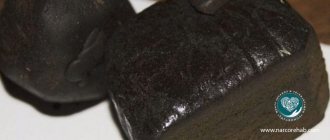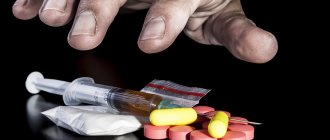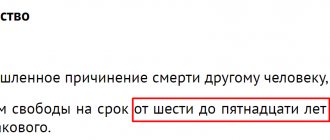Everything related to the illegal trafficking of drugs and substances containing them is under special attention of the Criminal Code (CC) of the Russian Federation. The production, storage, sale and distribution of drugs are criminal offenses (what is the sentence for selling drugs, read here). It is worth noting that the sentences for the listed acts are differentiated depending on the size of the batch of narcotic substances with which the offender was detained. Let's consider what a particularly large, large and significant amount of drugs is, and what punishment is provided for in the Criminal Code for various actions with drugs.
Criminal Code on illegal drug trafficking
Responsibility for any illegal manipulations with narcotic drugs is prescribed in the Criminal Code of the Russian Federation:
Additionally
If the actions of distribution and sale of narcotic drugs were committed by a minor, then no criminal case will be brought against him. However, in this case, the minor is registered with law enforcement agencies.
- illegal production, possession of drugs under the Criminal Code of the Russian Federation and distribution of drugs containing drugs - Art. 228.1, part 1, punishable by imprisonment from 4 to 8 years;
- distribution of drugs in public places and places of detention, or distribution using the media, including via the Internet - Article 228.1, part 2. Punishment under this article provides for from 5 to 12 years in prison;
- if the listed crimes were committed by several persons in a pre-planned conspiracy, or in a significant volume, then this is Article 228.1, Part 3, which prescribes imprisonment from 8 to 15 years.
Personal drug use is not a criminal offense; this offense is under the jurisdiction of the Code of Administrative Offenses (CAO) of the Russian Federation. Article 6.9 of the Code of Administrative Offenses provides for such an offense a fine of 4,000 to 5,000 rubles or 15 days of arrest. Citizens of another country in case of such a violation are subject to deportation outside the Russian Federation. It should be taken into account that everything said applies only to those who use drugs illegally, that is, without a doctor’s prescription. More information about liability for the use of narcotic substances can be found in the article https://lexconsult.online/6377-privlechenie-k-otvetstvennosti-za-upotreblenie-narkosoderzhashhih-veshhestv.
It is worth noting that possession of drugs containing drugs is a criminal act, therefore, almost everyone who uses drugs stores them for some time, and therefore commits a crime under Art. 228.1.
Administrative liability for amphetamine
The punishment for amphetamine is established in Article 6.9 of the Code of Administrative Offenses of the Russian Federation. It talks about using drugs without a prescription from a medical specialist, as well as refusing a medical examination. The violator faces a fine of up to 5 thousand rubles. He can also be arrested for up to 15 days.
Note!
Liability for amphetamine will be stricter if a foreigner or stateless person is caught using prohibited substances. In addition to a fine of up to 5 thousand rubles. he faces expulsion from the country.
Also, sanctions for amphetamine are established by Article 6.8 of the Code of Administrative Offenses of the Russian Federation. It lists penalties for the purchase, storage and transportation of prohibited substances. The punishment will be the same: a fine of up to 5 thousand rubles. and arrest for up to 15 days.
Classification of drug batch sizes
The drug batch size can be:
- significant - the weight of a substance that exceeds a single dose of use. If the weight of a drug is less than the established norm for a specific type of drug, then such a crime is classified as an administrative offense and is regulated by the Code of Administrative Offenses;
- large – the weight of the drug suitable for distribution;
- especially large – wholesale size of a batch of narcotic substances.
We present quantitative indicators that correspond to the above classification in a summary table. These standards are established and approved by Decree of the Government of the Russian Federation No. 1002 dated October 1, 2012.
| Significant, (g) | Large, (g) | Extra large, (g) | |
| marijuana (dried hemp) | 6 | 100 | 100000 |
| amphetamine | 0,2 | 1 | 200 |
| heroin | 0,5 | 2,5 | 1000 |
| soporific poppy (dried) | 20 | 500 | 100000 |
| spices (mixtures) | 0,05 | 0,25 | 500 |
As can be seen from the table, the established volumes for various types of drugs differ significantly from each other, and are directly dependent on the severity of the damage caused to human health. Therefore, just a quarter of a gram of spice is already considered a large size, and for marijuana a large size is from 100 g.
It is worth noting: if there is a need to determine the size of a mixture consisting of several components, then the definition of significant, large and especially large size is applied to the drug in the mixture for which the legislator has established more stringent control measures. Moreover, the position of the Supreme Court is that the size of the narcotic substance is equal to the weight of the mixture itself. If the size of solutions or liquids is determined, they are evaporated at a temperature of 70-110 degrees, and then the dry residue is measured.
New in blogs
The Government of the Russian Federation in accordance with Federal Law 18-FZ dated March 1, 2012. Resolution No. 1002 of October 1, 2012 was adopted “On approval of significant, large and especially large sizes of narcotic drugs and psychotropic substances, as well as significant, large and especially large sizes for plants containing narcotic drugs or psychotropic substances, or their parts containing narcotic drugs drugs or psychotropic substances, for the purposes of Articles 228, 2281, 229 and 2291 of the Criminal Code of the Russian Federation.” This resolution approved new sizes of narcotic drugs for their use in accordance with the new edition of Articles 228, 228.1, 229, 229.1 of the Criminal Code of the Russian Federation, which will come into effect from 01/01/2013. With the entry into force of Resolution No. 1002 (also from 01/01/2013), the new sizes of narcotic drugs and psychotropic substances will be divided into three categories: significant, large and especially large size. New editions of the “drug” articles of the Criminal Code of the Russian Federation and new sizes of drugs significantly tighten punishment for committing crimes. Take, for example, cannabis oil (“Khimka”). Currently, the large size is 0.4 grams, and the extra large size is 5 grams.The current version of Article 228.1 of the Criminal Code of the Russian Federation provides for the following sanctions: - under Part 1 for the sale of any weight up to 0.4 grams: from 4 to 8 years in prison; - under Part 2 for sale on a large scale, that is, from 0.4 to 5 grams: from 5 to 12 years in prison; - under Part 3 for sale on an especially large scale, that is, from 5 grams to infinity: from 8 to 20 years in prison. The version of Article 228.1 of the Criminal Code of the Russian Federation, which comes into force on January 1, 2013, will provide for other sanctions: - under Part 1, the sanctions and amounts of narcotic substances have not changed; — under Part 2, liability was introduced for sales in public places and using the Internet: from 5 to 12 years in prison; - under Part 3 for sale in a significant amount, that is, from 0.4 to 5 grams: from 8 to 15 years of imprisonment (now liability for the same weight is established by Part 2 and ranges from 5 to 12 years); - under Part 4 for sale on a large scale, that is, from 5 grams to 1 kg: from 10 to 20 years in prison; - under Part 5 for sale on an especially large scale, that is, over 1 kg: from 15 to 20 years in prison. Thus, the replacement from the beginning of 2013, for example, of a large amount of a narcotic drug with a significant amount will not in any way affect the sanction for this weight, therefore there are no grounds for revising already passed sentences. But the punishment for those who commit a crime related to drug trafficking is significantly increased, starting from 01/01/2013. The lower sanctions for all parts of Article 228.1 of the Criminal Code of the Russian Federation (except for the first) have increased by 2-3 years. It is also worth noting that due to the tougher penalties, Law 18-FZ will not have retroactive effect. That is, all persons who committed crimes related to drug trafficking before 01/01/2013. will be judged according to the currently valid version of the Criminal Code of the Russian Federation, even if the trial takes place after the beginning of 2013.
The only relaxation that is available in Resolution No. 1002 concerns aqueous solutions of narcotic drugs and psychotropic substances from List I. Since 2013, for all liquids and solutions containing at least one narcotic drug or psychotropic substance listed in List I, their quantity is determined by the dry weight residue after drying to constant weight at a temperature of + 70 ... + 110 degrees Celsius. In the Resolution in force until 2013, there was no such note, so the weight was determined by the weight of the entire mixture. On this basis, it is theoretically possible to review sentences after 01/01/2013.
The new table of sizes of narcotic drugs and psychotropic substances can be found below.
| 0,25 | 500 | ||
| N-(adamantan-1-yl)-1-pentyl-1H-indole-3-carboxamide and its derivatives, with the exception of derivatives included as independent items in the list | 0,05 | 0,25 | 500 |
| 3-Adamantoylindole[(Adamantan-1-yl)(1H-indol-3-yl)methanone] and its derivatives, with the exception of derivatives included as independent items in the list | 0,05 | 0,25 | 500 |
| Allylprodine | 0,5 | 2,5 | 500 |
| Alfameprodine | 0,5 | 2,5 | 500 |
| Alfamethadol | 0,5 | 2,5 | 500 |
| Alpha methylfentanyl | 0,0002 | 0,001 | 0,2 |
| Alpha methylthiofentanyl | 0,0002 | 0,001 | 0,2 |
| Alfaprodine | 0,5 | 2,5 | 500 |
| Alphacetylmethadol | 0,5 | 2,5 | 500 |
| 2-Amino-1-benzo[1,2-:4,5-b']difuran-4-ylethan and its derivatives, with the exception of derivatives included as independent items in the list | 0,05 | 0,25 | 500 |
| 2-Aminoindan and its derivatives, with the exception of derivatives included as independent items in the list | 0,05 | 0,25 | 500 |
| AMT (alpha-methyltryptamine) and its derivatives, with the exception of derivatives included as independent items in the list | 0,5 | 2,5 | 500 |
| Anileridine | 0,01 | 0,05 | 10 |
| Acetyl-alphamethylfentanyl | 0,0002 | 0,001 | 0,2 |
| Acetyldihydrocodeine | 0,5 | 2,5 | 500 |
| Acetylated opium | 0,5 | 5 | 1000 |
| Acetylcodeine | 0,5 | 2,5 | 1000 |
| Acetylmethadol | 0,5 | 2,5 | 500 |
| Acetyl fentanyl | 0,5 | 2,5 | 500 |
| 7-Acetoxymitragynine | 0,1 | 1 | 500 |
| Acetorphine | 0,0001 | 0,0005 | 0,1 |
| BDB [L-(3,4-methylenedioxyphenyl)-2-butanamine] | 0,5 | 2,5 | 500 |
| Bezitramide | 0,1 | 0,5 | 100 |
| Benzetidine | 0,05 | 0,25 | 50 |
| Benzylmorphine | 0,5 | 2,5 | 500 |
| 3-Benzoylindole (1H-indol-3-yl)-phenylmethanone and its derivatives, with the exception of derivatives included as independent items in the list | 0,05 | 0,25 | 500 |
| Beta-hydroxy-3-methylfentanyl | 0,002 | 0,01 | 2 |
| Beta-hydroxyfentanyl | 0,002 | 0,01 | 2 |
| Betameprodine | 0,5 | 2,5 | 500 |
| Betamethadol | 0,5 | 2,5 | 500 |
| Betaprodine | 0,5 | 2,5 | 500 |
| Betacetylmethadol | 0,5 | 2,5 | 500 |
| Brolamphetamine (DOB, d, L-4-bromo-2,5-dimethoxy-alpha-methyl-phenethylamine) | 0,01 | 0,05 | 10 |
| 3-Butanoyl-1-methylindole[1-(1-methyl-1H-indol-3-yl)butan-1-one] and its derivatives, with the exception of derivatives included as independent items in the list | 0,05 | 0,25 | 500 |
| (1-Butyl-1H-indol-3-yl) (naphthalene-1-yl)methanone (JWH-073) and its derivatives, with the exception of derivatives included as independent items in the list | 0,05 | 0,25 | 500 |
| Hashish (anasha, cannabis resin) | 2 | 25 | 10000 |
| Heroin (diacetylmorphine) | 0,5 | 2,5 | 1000 |
| Hydrocodone | 0,5 | 2,5 | 500 |
| 4-Hydroxytryptamine and its derivatives, with the exception of derivatives included as independent items in the list | 0,05 | 0,25 | 500 |
| 5-Hydroxy-N-methyltryptamine and its derivatives, with the exception of derivatives included as independent items in the list | 0,05 | 0,25 | 500 |
| N-hydroxy-MDA | 0,5 | 2,5 | 500 |
| 7-Hydroxymitragynine | 0,5 | 2,5 | 500 |
| Hydroxypetidine | 0,5 | 2,5 | 500 |
| 2-[(1R,3S)-3-Hydroxycyclohexyl]-5-(2-methyloctan-2-yl)phenol (CP 47.497) and its derivatives, with the exception of derivatives included as independent items in the list | 0,05 | 0,25 | 500 |
| 2-[(1R,3S)-3-Hydroxycyclohexyl]-5-(2-methylheptan-2-yl)phenol (CP47,497)-C6) and its derivatives, with the exception of derivatives included as independent items in the list | 0,05 | 0,25 | 500 |
| 2-[(1R,3S)-3-Hydroxycyclohexyl]-5-(2-methyldecan-2-yl)phenol (CP 47.497)-C9) and its derivatives, with the exception of derivatives included as independent items in the list | 0,05 | 0,25 | 500 |
| 2-[(1R,3S)-3-Hydroxycyclohexyl]-5-(2-methylnonan-2-yl)phenol (CP 47.497)-C8) and its derivatives, with the exception of derivatives included as independent items in the list | 0,05 | 0,25 | 500 |
| Hydromorphinol | 0,5 | 2,5 | 500 |
| 6-deoxycodeine | 0,5 | 2,5 | 500 |
| Desomorphine | 0,05 | 0,25 | 10 |
| Diampromide | 0,5 | 2,5 | 500 |
| Diacetylmorphine (heroin) | 0,5 | 2,5 | 1000 |
| Dihydromorphine | 0,5 | 2,5 | 500 |
| Dimenoxadol | 0,5 | 2,5 | 500 |
| N-Dimethylamphetamine | 0,5 | 2,5 | 500 |
| Dimethocaine [(3-diethylamino-2,2-dimethylpropyl)-4-aminobenzoate] | 0,5 | 5 | 500 |
| 2,5-Dimethoxyphenethylamine and its derivatives, with the exception of derivatives included as independent items in the list | 0,05 | 0,25 | 500 |
| Dimepheptanol | 0,5 | 2,5 | 500 |
| Dimethylthiambutene | 0,5 | 2,5 | 500 |
| (6aR,10aR)-9-(Hydroxymethyl)-6,6-dimethyl-3-(2-methyloctan-2-yl)-6a, 7, 10, 10a-tetrahydrobenzo[c]chromen-1-ol (HU- 210) and its derivatives, with the exception of derivatives included as independent items in the list | 0,05 | 0,25 | 500 |
| 2C-T-7(2,5-dimethoxy-4-N-propylthiophenethylamine) | 0,2 | 1 | 200 |
| Dioxafetyl butyrate | 0,1 | 0,5 | 100 |
| Dipipanon | 0,01 | 0,05 | 10 |
| Difenoxin | 0,1 | 0,5 | 100 |
| Diethylthiambutene | 0,5 | 2,5 | 500 |
| DMA (d, L-2,5-dimethoxy-alpha-methyl-phenyl-ethylamine) | 0,5 | 2,5 | 500 |
| DMHP (dimethylheptylpyran) | 0,02 | 0,1 | 20 |
| DMT (dimethyltryptamine) and its derivatives, with the exception of derivatives included as independent items in the list | 0,5 | 2,5 | 500 |
| DOX (d, L-2,5-dimethoxy-4-chloroamphetamine) | 0,01 | 0,05 | 10 |
| DOET (d, L-2,5-dimethoxy-4-ethyl-amphetamine) | 0,01 | 0,05 | 10 |
| Drotebanol | 0,5 | 2,5 | 500 |
| DET (N,N-diethyltryptamine) | 0,5 | 2,5 | 500 |
| Isomethadone | 0,5 | 2,5 | 500 |
| Cannabis (marijuana) | 6 | 100 | 100000 |
| Ketobemidon | 0,01 | 0,5 | 10 |
| Clonitazene | 0,0002 | 0,001 | 0,2 |
| Kodoxim | 0,5 | 2,5 | 500 |
| Homemade preparations from ephedrine (pseudoephedrine) or from preparations containing ephedrine (pseudoephedrine) | 0,5 | 10 | 500 |
| Homemade preparations from phenylpropanolamine or from preparations containing phenylpropanolamine | 0,5 | 10 | 500 |
| Levomethorphan | 0,5 | 2,5 | 500 |
| Levomoramide | 0,5 | 2,5 | 500 |
| Levorphanol (Lemoran) | 0,5 | 2,5 | 500 |
| Levophenacylmorphan | 0,5 | 2,5 | 500 |
| d-Lysergide (LSD, LSD-25) | 0,0001 | 0,005 | 0,1 |
| Coca leaf | 20 | 250 | 20000 |
| Poppy straw | 20 | 500 | 100000 |
| Cannabis oil (hashish oil) | 0,4 | 5 | 1000 |
| MBDB [N-methyl-1-(3,4-methylenedioxyphenyl)-2-butanamine] | 0,5 | 2,5 | 500 |
| MDA (tenamphetamine) | 0,6 | 3,0 | 600 |
| MDMA (d, L-3,4-methylenedioxy-N-alpha-dimethyl-phenyl-ethylamine) | 0,6 | 3,0 | 600 |
| 3-Monoacetylmorphine | 0,5 | 2,5 | 1000 |
| 6-Monoacetylmorphine | 0,5 | 2,5 | 1000 |
| Mescaline | 0,5 | 2,5 | 500 |
| Methadone (phenadone, dolophine) | 0,5 | 2,5 | 1000 |
| Methadone intermediate (4-cyano-2-dimethylamino-4,4-diphenylbutane) | 0,5 | 2,5 | 1000 |
| Metazocin | 2 | 10 | 2000 |
| Methamphetamine (Pervitin) | 0,3 | 2,5 | 500 |
| Methyldesorphin | 0,5 | 2,5 | 500 |
| Methyldihydromorphine | 0,5 | 2,5 | 500 |
| Methylenedioxypyrovalerone | 0,6 | 3,0 | 600 |
| 6-methyl-2-[(4-methylphenyl)amino]-4H-3,1-benzoxazin-4-one | 0,05 | 0,25 | 500 |
| Methylone (3,4-methylenedioxy-N-methylcathinone) | 0,2 | 2,5 | 500 |
| 2-Methyl-1-pentyl-1H-indol-3-yl-(1-naphthyl) methane (JWH-196) and its derivatives, with the exception of derivatives included as independent items in the list | 0,05 | 0,25 | 500 |
| 2-Methyl-1-pentyl-1H-indol-3-yl-(4-methyl-1-naphthyl)methane (JWH-194) and its derivatives, with the exception of derivatives included as independent items in the list | 0,05 | 0,25 | 500 |
| 2-Methyl-1-pentyl-1H-indol-3-yl-(4-methoxy-1-naphthyl)methane (JWH-197) and its derivatives, with the exception of derivatives included as independent items in the list | 0,05 | 0,25 | 500 |
| (2-Methyl-1-pentyl-1H-indol-3-yl)(naphthalene-1-yl)methanone (JWH-007) and its derivatives, with the exception of derivatives included as independent items in the list | 0,05 | 0,25 | 500 |
| (4-Methylnaphthalene-1-yl)(2-methyl-1-pentyl-1H-indo-3-yl)methanone (JWH-149) and its derivatives, with the exception of derivatives included as independent items in the list | 0,05 | 0,25 | 500 |
| (2-Methyl-1-pentyl-1H-indol-3-yl)(4-methoxynaphthalen-1-yl)methanone (JWH-098) and its derivatives, with the exception of derivatives included as independent items in the list | 0,05 | 0,25 | 500 |
| 3-methylthiofentanyl | 0,0002 | 0,001 | 0,2 |
| 3-methylfentanyl | 0,0002 | 0,001 | 0,2 |
| N-methylephedrone and its derivatives, with the exception of derivatives included as independent items in the list | 0,2 | 1 | 200 |
| Methoxetamine [2-(3-methoxyphenyl)-2-ethylamino)cyclohexanone] and its derivatives, with the exception of derivatives included as independent items in the list | 0,2 | 1 | 500 |
| N-[3-(2-methoxyethyl)-4,5-dimethyl-1,3-thiazol-2-ylidene]-2,2,3,3-tetramethylcyclopropane-1-carboxamide | 0,05 | 0,25 | 500 |
| Metopon | 0,5 | 2,5 | 500 |
| Mephedrone (4-methylmethcathinone) | 0,2 | 2,5 | 500 |
| Mirofin | 0,5 | 2,5 | 500 |
| Mitragynine (9-methoxy-corynantheidine) and its derivatives, with the exception of derivatives included as independent items in the list | 0,5 | 2,5 | 500 |
| The milky juice of different types of poppy, which are not poppy somniferous (plant of the species Papaver somniferum L), but containing poppy alkaloids included in the lists of narcotic drugs and psychotropic substances | 1 | 25 | 5000 |
| MMDA (2-methoxy-alpha-4-methyl-4,5-(methylenedioxy)-phenethylamine) | 0,5 | 2,5 | 500 |
| Moramide, intermediate (2-methyl-3-morpholine-1,1-diphenylpropanecarboxylic acid) | 0,5 | 2,5 | 500 |
| Morpheridine | 0,5 | 2,5 | 500 |
| Morphine methyl bromide | 0,5 | 2,5 | 500 |
| Morphine-N-oxide | 0,5 | 2,5 | 500 |
| (1-[2-(4-Morpholino)ethyl]-1-H-indol-3-yl)(naphthalene-1-yl)methane (JWH-195) and its derivatives, excluding derivatives included as separate entries to the list | 0,05 | 0,25 | 500 |
| (4-Methylnaphthalene-1-yl)(1-[2-(4-morpholino)ethyl]-1H-indol-3-yl)methane (JWH-192) and its derivatives, with the exception of derivatives included as independent entries to the list | 0,05 | 0,25 | 500 |
| (4-Methoxy-1-naphthyl)(1-[2-(4 morpholino)ethyl]-1H-indol-3-yl)methane (JWH-199) and its derivatives, with the exception of derivatives included as independent entries in scroll | 0,05 | 0,25 | 500 |
| (1-[2-(4-Morpholino)ethyl]-1H-indol-3-yl)(naphthalene-1-yl)methanone (JWH-200) and its derivatives, with the exception of derivatives included as independent items in the list | 0,05 | 0,25 | 500 |
| (4-Methylnaphthalene-1-yl)(1-[2-(4-morpholino)ethyl]-1H-indol-3-yl)methanone (JWH-193) and its derivatives, excluding derivatives included as independent entries to the list | 0,05 | 0,25 | 500 |
| (4-Methoxy-1-naphthyl)(1-[2-(4-morpholino)ethyl]-1H-indol-3-yl)methanone (JWH-198) and its derivatives, excluding derivatives included as separate entries to the list | 0,05 | 0,25 | 500 |
| MPPP (MPPP (1-methyl-4-phenyl-4-piperidinol propionate (ester)) | 0,5 | 2,5 | 500 |
| (E)-1-[1-(Naphthalene-1-ylmethylidene)-1H-inden-3-yl]pentane (JWH-176) and its derivatives, with the exception of derivatives included as independent items in the list | 0,05 | 0,25 | 500 |
| (Naphthalene-1-yl)(1H-pyrrol-3-yl)methanone and its derivatives, with the exception of derivatives included as independent items in the list | 0,05 | 0,25 | 500 |
| (Naphthalene-1-yl)(4-pentyloxynaphthalene-1-yl)methanone and its derivatives, with the exception of derivatives included as independent items in the list | 0,05 | 0,25 | 500 |
| 3-Naphthoylindole [(1H-indol-3-yl)(naphthalene-1-yl) methanone] and its derivatives, with the exception of derivatives included as independent items in the list | 0,05 | 0,25 | 500 |
| Nikodikodin | 0,5 | 2,5 | 500 |
| Nicocodin | 0,5 | 2,5 | 500 |
| Nicomorphine | 0,5 | 2.5 | 500 |
| Noracimethadol | 0,5 | 2,5 | 500 |
| Norcodeine | 0,5 | 2,5 | 500 |
| Norlevorphanol | 0,5 | 2,5 | 500 |
| Normethadone | 0,5 | 2,5 | 500 |
| Normorphine | 0,5 | 2,5 | 500 |
| Norpipanon | 0,5 | 2,5 | 500 |
| Oxymorphone | 0,5 | 2,5 | 500 |
| Opium is the coagulated juice of the sleeping pill poppy (plant of the species Papaver somniferum L) | 1 | 25 | 5000 |
| Oripavin | 0,2 | 1 | 200 |
| Para-fluorofentanyl (para-fluorofentanyl) | 0,0002 | 0,001 | 0,2 |
| Parahexyl | 0,05 | 0,25 | 50 |
| (4-Methylnaphthalene-1-yl)(1-pentyl-1H-indol-3-yl) methanone (JWH-122) and its derivatives, with the exception of derivatives included as independent items in the list | 0,05 | 0,25 | 500 |
| (4-Methoxynaphthalene-1-yl)(1-pentyl-1H-indol-3-yl)methanone (JWH-081) and its derivatives, with the exception of derivatives included as independent items in the list | 0,05 | 0,25 | 500 |
| (Naphthalene-1-yl)(1-pentyl-1H-indol-3-yl)methanone (JWH-018) and its derivatives, with the exception of derivatives included as independent items in the list | 0,01 | 0,05 | 100 |
| 1-Pentyl-1H-indol-3-yl-(1-naphthyl)methane (JWH-175) and its derivatives, with the exception of derivatives included as independent items in the list | 0,05 | 0,25 | 500 |
| 1-Pentyl-1H-indol-3-yl-(4-methyl-1-naphthyl)methane (JWH-184) and its derivatives, with the exception of derivatives included as independent items in the list | 0,05 | 0,25 | 500 |
| 1-Pentyl-1H-indol-3-yl-(4-methoxy-1-naphthyl)methane (JWH-185) and its derivatives, with the exception of derivatives included as independent items in the list | 0,05 | 0,25 | 500 |
| PEPAP (L-phenethyl-4-phenyl-4-piperidinol acetate (ester)) | 0,5 | 2,5 | 500 |
| Pethidine | 0,5 | 2,5 | 500 |
| Pethidine, intermediate A(4-cyano-1-methyl-4-phenylpiperidine) | 0,5 | 2,5 | 500 |
| Pethidine, intermediate B (4-phenylpiperidine-4-carboxylic acid ethyl ester) | 0,5 | 2,5 | 500 |
| Pethidine, intermediate C (1-methyl-4-phenylpiperidine-4-carboxylic acid) | 0,5 | 2,5 | 500 |
| Piminodine | 0,5 | 2,5 | 500 |
| (Piperidin-2-yl)diphenylmethane and its derivatives, with the exception of derivatives included as independent items in the list | 0,05 | 0,25 | 500 |
| (Pyrrolidin-2-yl)diphenylmethane and its derivatives, with the exception of derivatives included as independent items in the list | 0,05 | 0,25 | 500 |
| PMA(4-methoxy-alpha-methylphenyl-ethylamine) | 0,01 | 0,1 | 10 |
| Proheptazine | 0,5 | 2,5 | 500 |
| Psilocybin | 0,05 | 0,25 | 50 |
| Psilocin | 0,05 | 0,25 | 50 |
| Racemethorphan | 0.5 | 2,5 | 500 |
| Racemoramide | 0,5 | 2,5 | 500 |
| Racemorphan | 0,5 | 2,5 | 500 |
| Rolicyclidine | 0,02 | 0,1 | 20 |
| Salvinorin | 0,05 | 0,25 | 50 |
| 2C-B (4-bromo-2,5-dimethoxyphenethylamine) | 0,01 | 0,5 | 10 |
| STP (DOM) [2-amino-1-(2,5-dimethoxy-4-methyl)phenylpropane] | 0,01 | 0,05 | 10 |
| Tebacon (acetyldihydrocodeinone) | 0,5 | 2,5 | 500 |
| Tenocyclidine (TCP) | 0,02 | 0,1 | 20 |
| Tetrahydrocannabinol (all isomers) | 0,05 | 0,25 | 50 |
| 2-Thiophen-2-ylethylamine and its derivatives, with the exception of derivatives included as independent items in the list | 0,05 | 0,25 | 500 |
| Thiofentanil | 0,0002 | 0,001 | 0,2 |
| TMA (d, L-3,4,5-trimethoxy-alpha-methylphenyl-amine) | 0,01 | 0,05 | 10 |
| TFMPP(1-(3-trifluoromethylphenyl)piperazine) | 0,3 | 1,5 | 300 |
| Phenadoxone | 0,5 | 2,5 | 500 |
| Phenazocine | 2 | 10 | 2000 |
| Fenampromide | 0,5 | 2,5 | 500 |
| Phenatine | 0,5 | 2,5 | 500 |
| 1-Phenylpiperazine and its derivatives, with the exception of derivatives included as independent items in the list | 0,05 | 0,25 | 500 |
| 1-Phenylcyclohexylamine and its derivatives, with the exception of derivatives included as independent items in the list | 0,05 | 0,25 | 500 |
| Phenylacetylindole [1-(1H-indol-3-yl)-2-phenylethanone] and its derivatives, with the exception of derivatives included as independent items in the list | 0,05 | 0,25 | 500 |
| Phencyclidine | 0,02 | 0,1 | 200 |
| Phenomorphan | 0,5 | 2,5 | 500 |
| Phenoperidine | 0,5 | 2,5 | 500 |
| Fenfluramine | 0,3 | 1,5 | 300 |
| Folkodin | 0,5 | 2,5 | 500 |
| Furetidine | 0,5 | 2,5 | 500 |
| Chlorophenylpiperazine | 0,1 | 1 | 100 |
| Ecgonine, its esters and derivatives, which can be converted to ecgonine and cocaine | 0,2 | 1 | 200 |
| Poppy straw extract (poppy straw concentrate) | 1 | 5 | 500 |
| N-ETHYL-MDA (d, LN-ethyl-alpha-methyl-3,4-(methylenedioxy)-phenethylamine) | 0,5 | 2,5 | 500 |
| Ethylmethylthiambutene | 0,5 | 2,5 | 500 |
| 1-Ethyl-1-pentyl-3-(1-naphthoyl)indole (JWH-116) and its derivatives, with the exception of derivatives included as independent items in the list | 0,05 | 0,25 | 500 |
| Ethycyclidine | 0,02 | 0,1 | 20 |
| Ethoxyridine | 0,5 | 2,5 | 500 |
| Etonitazene | 0,0001 | 0,001 | 0,1 |
| Etorphine | 0,0001 | 0,001 | 0,1 |
| Etryptamine | 0,5 | 2,5 | 500 |
| Ephedrone (methcathinone) and its derivatives, with the exception of derivatives included as independent items in the list | 0,2 | 2,5 | 500 |
The amount of narcotic drugs and psychotropic substances is determined after drying to constant weight at a temperature of +110 ... +115 degrees Celsius.
PSYCHOTROPIC SUBSTANCES
| Amphetamine and its derivatives, with the exception of derivatives included as independent items in the list | 0,2 | 1 | 200 |
| Cathene (d-norpseudoephedrine) | 0,2 | 1 | 200 |
| Cathinone (L-alpha-aminopropiophenone) and its derivatives, with the exception of derivatives included as independent items in the list | 0,2 | 1 | 200 |
| Meclocqualone | 0,5 | 2,5 | 500 |
| Methaqualone | 1 | 5 | 1000 |
| 4-methylaminorex | 0,5 | 2,5 | 500 |
| Methylphenidate (Ritalin) | 0,2 | 1 | 200 |
| Phenethylline | 0,2 | 1 | 200 |
| 1-Phenyl-2-propanone | 1 | 10 | 2000 |
Note. For all liquids and solutions containing at least one narcotic drug or psychotropic substance listed in List I, their quantity is determined by the mass of the dry residue after drying to constant weight at a temperature of + 70 ... + 110 degrees Celsius.
SIGNIFICANT, LARGE AND ESPECIALLY LARGE
sizes for plants containing narcotic drugs or psychotropic substances, or their parts containing narcotic drugs or psychotropic substances, for the purposes of Articles 228, 2281, 229 and 2291 of the Criminal Code of the Russian Federation
| Plant name | Significant size (over grams) | Large size (over grams) | Extra large size (over grams) |
| Blue lotus (plant of the species Nymphea caerulea) | 3 | 30 | 3000 |
| Fruiting body of mushrooms of any kind containing psilocybin and/or psilocin | 10 | 100 | 10000 |
| Mescaline cactus (Lophophorawilliamsii plant) and other mescaline cactus species | 50 | 250 | 25000 |
| Khat (plant of the species Catha edulis) | 100 | 1000 | 100000 |
| Coca bush (plant of any species of the genus Erythroxylon) | 20 | 250 | 20000 |
| Hemp (plant of the genus Cannabis) | 6 | 100 | 100000 |
| Soporific poppy (plant of the species Papaver somniferum L) and other species of poppy of the genus Papaver containing narcotic drugs | 20 | 500 | 100000 |
| Hawaiian rose seeds (seeds of the Argyrea nervosa plant) | 3 | 30 | 3000 |
| Diviner's sage (plant of the species Salvia divinorum) | 3 | 30 | 3000 |
Notes. 1. The quantity is determined after drying to constant weight at a temperature of +110 ... +115 degrees Celsius.
2. Significant, large and especially large sizes for plants containing narcotic drugs or psychotropic substances correspond to significant, large and especially large sizes for their parts containing narcotic drugs or psychotropic substances.
What do judicial statistics say?
According to the Judicial Department of the Supreme Court of the Russian Federation, every seventh sentence in the Russian Federation is passed under Article 228 . Thus, in 2021, 658.3 thousand people were convicted under all elements of the Criminal Code of the Russian Federation, of which Article 228 with all its parts accounted for 13.4% of all sentences. For comparison: a year earlier the share was 14.3% (total number of convicts - 697 thousand), in 2014 - 15.2% (out of 719.3 thousand). If we take all drug-related charges, then a quarter of all prisoners are imprisoned under them.
The most widespread is Article 228 (acquisition and possession without the purpose of distribution), which in 2021 accounted for 79% of all sentences (69.6 thousand). Drug sales (228.1) account for 21% of convictions.
The majority of those convicted are young people (age group from 18 to 29 years).
The most common sentence for drug-related crimes is imprisonment for 3-5 years. At the same time, only 0.3% of criminal cases are released from punishment .
Art. 72.1 of the Criminal Code of the Russian Federation gives the court the opportunity to oblige the convicted person to undergo drug addiction treatment (if the main punishment is not related to imprisonment). In Art. 82.1 provides for the opportunity for a person sentenced to a real term to voluntarily undergo treatment for drug addiction with a deferred sentence.
How is criminal liability for drugs determined?
Under which part of Article 228 of the Criminal Code of the Russian Federation a detainee will be held depends on several factors:
- the type and quantity of the substance seized from him;
- gravity of the crime;
- the number of persons involved in this case;
- the role of the criminal in the hierarchy and community of drug traffickers.
Most often, charges are brought under Article 228 of the Criminal Code of the Russian Federation and 228.1 of the Criminal Code of the Russian Federation. These regulations apply to the following types of drug crimes:
- illegal acquisition, storage, production or processing, transportation of narcotic drugs or plants containing narcotic or psychotropic substances;
- illegal production, transfer or sale of narcotic substances, plants or psychotropic substances, as well as their analogues.
In some cases, the detainee is held liable under Article 229 of the Criminal Code of the Russian Federation - “Theft or extortion of narcotic drugs.”
Features of law enforcement
The 2021 report by the Institute for Law Enforcement Problems, “Drug Crimes in Russia: Analysis of Judicial and Criminal Statistics,” notes that consumers in Russia are persecuted more often than distributors . The authors identified “artificial distortion of the masses of seized drugs by law enforcement agencies.” “The quantities of marijuana and hashish most often seized from drug users are just sufficient to qualify the offense as a criminal offense, and these quantities do not significantly exceed the significant amount required to initiate a criminal case,” the report says.
Alexey Knorre, “Drug crimes in Russia: analysis of judicial and criminal statistics”
Researchers call a separate problem the fact that “law enforcement officers understand a drug not as a pure narcotic substance found in a mixture, but as the entire mixture.
According to Alexei Knorre, an expert at the Institute of Law Enforcement Problems of the European University, there are no official statistics on bringing law enforcement officers to justice for falsifying drug cases. However, content analysis of the media over the past 5 years has revealed approximately 500 cases in which a law enforcement officer was detained, arrested, or convicted of drug-related fraud.








